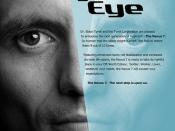Mitchell O'Brien Frankenstein/Bladerunner Essay
As responders, our understanding of the texts is shaped by the context and medium in which they're presented.
The order of events as well as characterisation within Frankenstein and Bladerunner exist in alternating historical contexts. Conversely, both texts act as drivers for their respective composers to generate similar argument or dispute regarding ethical issues that rise above generations. Mary Shelley, author of Frankenstein (1818), as well as Ridley Scott, director of Bladerunner: The Director's Cut (1992), ask through their texts if it is ethical for scientists of their generation to superimpose the inquisitiveness of their respective science and/or technology onto a future, full of innocence, as well as the implications for creator (Frankenstein and Tyrell), and creation (the monster, replicants) if successful? In Frankenstein, Shelley primarily depends on literary techniques like the theme of nature and different perspectives of the story through numerous narrations to depict her opinion of man vs.
artificial life. Scott contextualises this warning or opinion, depending of filmic, aural, and visual techniques as well as dialogue in unison with typical narrative techniques to epitomise the reshaping of context through changing values and perspectives regarding similar content.
Shelley creates a character, Victor Frankenstein, the crucial persona of Frankenstein, who epitomises the arrogance involved in science as well as being depicted as the imbecile who wrongly toys with the theory of creation, with the powers of his monster created far beyond any human understanding. His actions identically demonstrate the obsession of the Gothic Romantics and their personal fear of scientific discovery. Shelley represents an idea of corruption incessantly displayed in science and demonstrates this through Frankenstein's fall from grace with the use of juxtaposition. Juxtaposition is utilised to convey her cautionary message, as well as portraying the punishment for rising above the...


